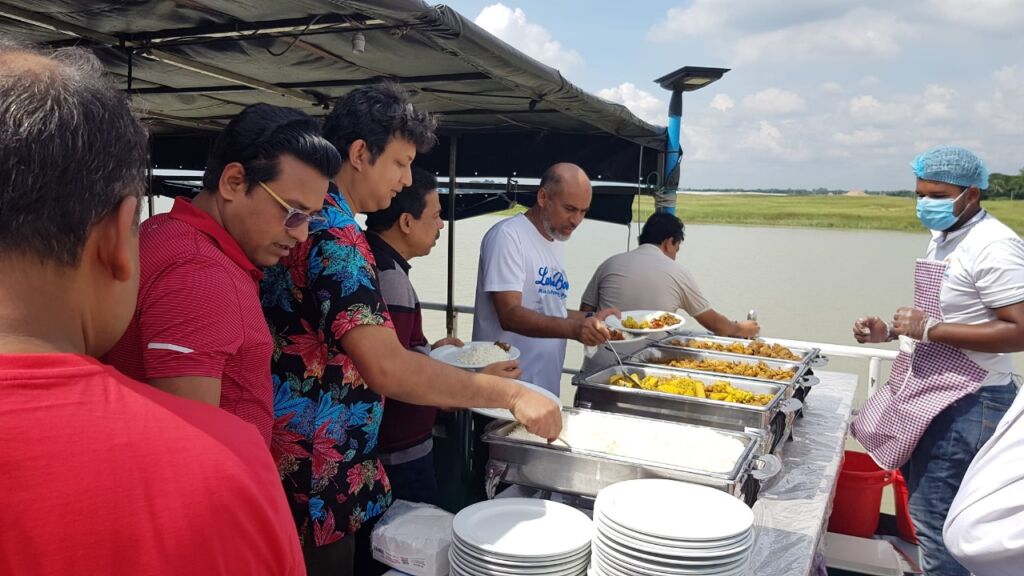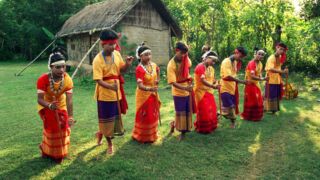
Bangladesh has a coastline of 575 kilometers along the Bay of Bengal. Most of the country consists of the delta of the rivers Ganges (called Padma in Bangladesh) and Brahmaputra (called Jamuna in Bangladesh). Both rivers make many branches that flow out over the land in the form of a fan. The Padma and Jamuna flow together in the Meghna, the chief of the many branches that flow into the Bay of Bengal. The land is very fertile due to the deposits of the rivers, but also very prone to flooding.
The plain of the delta is bounded in the northeast, along the border with the Indian state of Meghalaya, by the Shillong Plateau. The southern edge of the plateau is steep and the rivers that flow from the plateau to the plain have carved themselves deep into the edge of the plateau here. The only mountains in Bangladesh, the Chittagong Hill Tracts, are in the extreme southeast, along the border with Myanmar. Among these mountains is the highest mountain in Bangladesh, Mowdok Mual (1052 m). Cox’s Bazar south of the city of Chittagong has the longest natural beach in the world.
Flora and fauna of Bangladesh
Most of the land in Bangladesh is in human use due to its high population density. Forests cover about 50% of the country. These include bamboo forests in the northeast and mangrove in the swampy area of the Sundarbans in the southwest.
Bangladesh has a rich rainforest fauna. For example, the endangered (royal) Bengal tiger still lives in the southwest of the country in the Sundarbans region.
Climate and environment of Bangladesh
Bangladesh is located just south of the Tropic of Cancer and has a tropical climate with mild dry winters from October to March when winds blow from the north, a hot humid summer from March to June and a humid and warm rainy season (monsoon) from June to October . The coldest month is January with temperatures below 20 degrees and the hottest month is April, when the temperature can reach high into the 30s.
Because most of Bangladesh consists of low-lying plains, major floods regularly occur in the country. Floods mainly occur during monsoons. During an average monsoon, more than two-thirds of Bangladesh is under water. Although the monsoon also causes an increase in precipitation in Bangladesh, the increase in the water supply from the major rivers is the main cause. When the water level in all three major rivers reaches a maximum simultaneously, this is a disaster for the population. In 1998, 2004 and 2007, millions of people became homeless and the floods caused hundreds of victims. However, the floods are not just a problem. The annual supply of fertile sludge is of great importance for agriculture. Since the economy is heavily dependent on agriculture, infrastructure to stop the floods is controversial. The rivers are largely not provided with dikes.
Bangladesh is particularly sensitive to the effects of climate change, including sea level rise and erosion. In addition to flooding, tropical cyclones, tornadoes and tidal waves also occur regularly during the monsoon. The effects of these natural disasters are exacerbated by deforestation, soil depletion and erosion.
Bangladesh is one of the most sensitive areas to sea level rise. The increase predicted by many climatologists due to global warming could hit the country hard in the future. That is why the politics in Bangladesh are very strong in favor of measures that reduce greenhouse gas emissions. An example is a ban on petrol in the big cities, where today all vehicles run on gas.
Another major problem is groundwater contamination with naturally occurring arsenic. This is primarily a problem contributed by Western NGOs who have encouraged well drilling as an alternative to the polluted river water. Arsenic poisoning threatens about 25% of the population. The working part of the population is also growing faster than the number of jobs in the most important sector, agriculture.
Population of Bangladesh
Bangladesh is one of the most densely populated countries in the world. At the beginning of the 20th century, the area that is now Bangladesh had some thirty million inhabitants; that number has now increased fivefold. The population is quite homogeneous: 98% is ethnic Bangladeshi. The remaining 2% are non-Bengali Muslims and various peoples living in the Chittagong Hills.
Religion of Bangladesh
The main religion is Islam, which is practiced by 90 to 95% of the population. Most of them are Sunnis. There are also some Shia groups, especially among the descendants of immigrants from Iran. Islam was declared the state religion in 1988.
Hinduism is the other major religion at 4 to 8% (mainly among the lower caste population). There are also small groups of Buddhists, Christians and animists. Theravada Buddhism in Bangladesh is mainly practiced in the southern district of Bandarban.
According to an evangelical Christian source, Christianity is growing in Bangladesh. In 2019, Bangladesh had about 600,000 Christians, of which just over half are Catholics.
In Bangladesh, in addition to the Islamic, Hindu holy days are also celebrated, such as Janmashtami.
Language of Bangladesh
The Bengalis speak Bengali (also called Bangla) which is written in a script similar to Devanagari. Bengali is also the country’s official language. English is also still used, mainly in educational institutions and in government. Furthermore, most non-Bengali Muslims speak Urdu. This was also the language imposed from West Pakistan prior to independence.
Economy
The textile industry is one of Bangladesh’s largest sources of income.
Despite a lot of international aid, Bangladesh is still one of the poorest countries in the world. Overpopulation, natural disasters and political instability contribute to this. Almost 60% of the goods are transported by ship.
Agriculture
Nearly two-thirds of Bangladesh’s population works in agriculture. Rice is the main product, of which the country is the fourth largest producer in the world. Other important products are jute of which the country is the second largest producer in the world, sugar cane, tobacco and grain.
Industry
The main industrial sector is textiles. An estimated 4 million people work in textile production, which is export-oriented and the main source of foreign exchange. Recently, disasters such as the Rana Plaza collapse have sparked international outrage. Initiatives were subsequently launched such as Fair Production to improve working conditions. With 1,134 dead, the collapse is considered the deadliest disaster ever to hit a textile factory and the deadliest architectural disaster in modern history.
In October 2013, construction started on the first nuclear power plant in Ruppur in the northwest of the country. The Ruppur Nuclear Power Plant will have two Russian nuclear reactors to generate 1000 megawatts (MW) of electricity. The International Atomic Energy Agency gave Bangladesh permission to build a power plant in 2007. In December 2015, the final order for two reactors with a capacity of 1200 MW each followed. Work started in 2016, 160 kilometers from the capital Dhaka. Russia is giving a large loan on soft terms to finance the estimated construction cost of $12.65 billion. The power stations will come into operation later than initially expected in 2022 and 2023.











